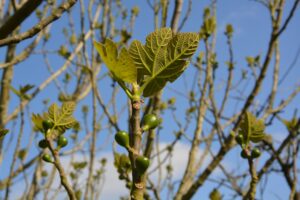In this blog post, we will go over the essential elements that contribute to the optimal placement for apple trees. Whether you’re cultivating a small garden or a sprawling orchard, understanding these factors will help you pick the perfect place to plant an apple tree.
Cross-Pollination
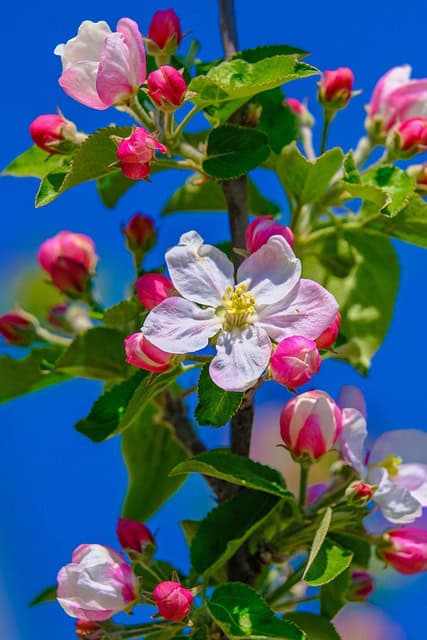
When it comes to successfully growing apple trees, cross-pollination is crucial for a bountiful harvest. Although some apple varieties can self-pollinate, most produce better fruit when pollinated by another variety, enhancing fruit set and yielding larger apples. Ideally, your apple trees should be planted within 100 feet of one another to ensure effective cross-pollination. This distance increases the likelihood that bees and other pollinators will travel between the trees to transfer pollen.
Selecting complementary apple tree varieties is essential. For instance, if you plant a Honeycrisp apple tree, pairing it with a different variety like Fuji or Gala enhances pollination efficiency. The bloom periods of your selected varieties should also align closely. If one variety flowers significantly later than the other, cross-pollination may fail, leading to fewer apples. Evaluating your local climate zone is also important; some varieties may thrive in your area more than others. By selecting compatible varieties and ensuring they are spaced appropriately, you’ll set the stage for a fruitful apple orchard in your garden.
Sun
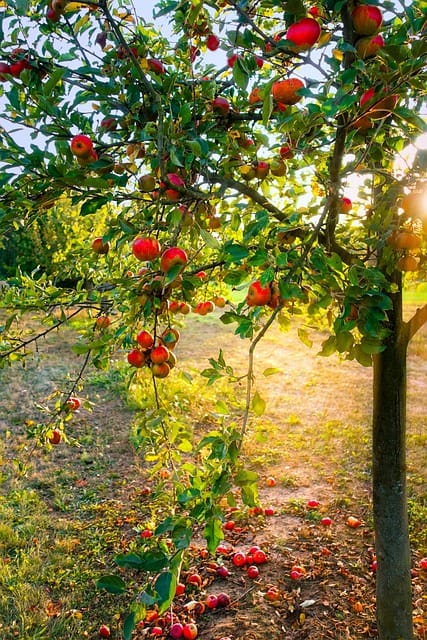
Apple trees thrive in full sun, requiring at least eight hours of direct sunlight each day. When planning the best place to plant apple trees, consider their positioning in relation to the sun’s path throughout the year. Ideally, they should be planted in a location that receives unobstructed sunlight, especially during the spring when they are flowering. Lack of sunlight can lead to reduced fruit production, poor fruit quality, and higher susceptibility to diseases.
To ensure they receive adequate sun, avoid planting apple trees in shaded spots created by nearby structures or larger trees. An open area that faces south or southwest is generally optimal, as this will provide the most consistent sunlight throughout the day. Additionally, monitor how shadows change with the seasons, especially if other plants might encroach on the apple trees’ sunlight. Proper placement is crucial not only for their health but also for maximizing your future apple harvest.
Soil
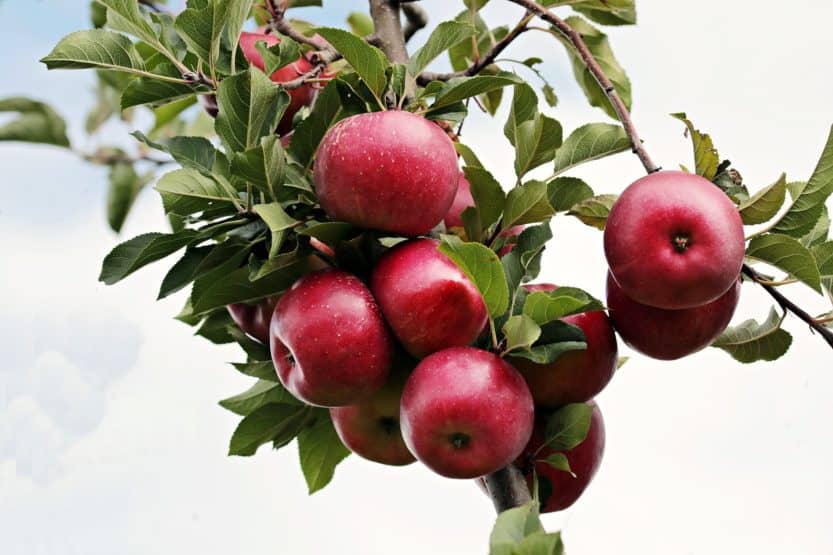
Soil quality plays a pivotal role in the success of apple trees, making good soil drainage vital. Apple trees prefer loamy soil that is well-draining while still retaining some moisture for optimal growth. Compacted or heavy clay soil can hinder root development and lead to issues such as root rot, which can devastate your trees. To determine if your chosen planting area has suitable drainage, perform a simple test: dig a hole about 12 inches deep and fill it with water. If the water drains away within a few hours, the drainage is sufficient for apple trees.
Improving soil drainage can often be accomplished by mixing in organic matter, such as compost, sand, or peat moss, which will enhance both texture and nutrient content. Additionally, consider creating raised beds if your natural soil drainage is poor. Raised beds allow for superior drainage and can keep the root zone warmer in early spring, giving your trees a jumpstart in their growing season. Before planting, it’s wise to conduct a soil test to assess its pH levels and nutrient composition. Apple trees thrive in a slightly acidic to neutral pH (between 6.0 and 7.0). If your soil is too acidic or alkaline, remedies such as lime (to raise pH) or sulfur (to decrease pH) can be applied to create an ideal growing environment for your apple trees.
Surroundings
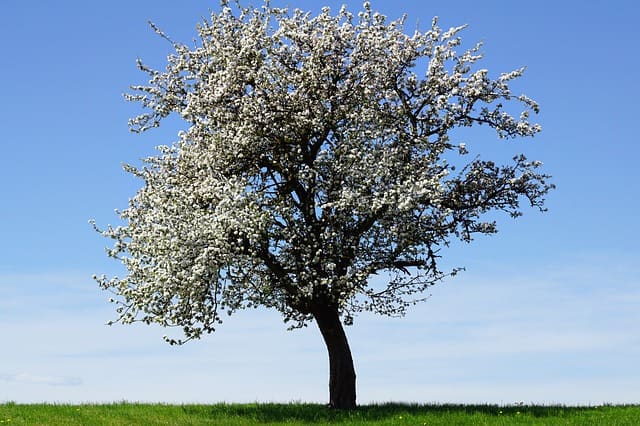
When selecting the best place to plant apple trees, the surrounding environment is a key consideration. The area near your apple trees can greatly influence their growth and fruit production. It’s beneficial to plant apple trees in an area that is protected from strong winds, such as near a fence or wall. Wind can cause physical damage to branches and can also impede the pollination process by disturbing bees and other pollinators.
Additionally, consider the presence of nearby plants. Certain plants can create competition for nutrients and water, which can hinder the growth of your apple trees. It’s best to avoid planting them too close to aggressive weeds or other deep-rooted plants that may siphon moisture and nutrients from the soil. Conversely, companion planting with flowers that attract pollinators can enhance the health and productivity of your apple trees. Marigolds, for instance, can help repel pests while drawing in bees, which are essential for effective pollination. Evaluating the overall microclimate of your chosen location, including factors such as moisture levels and temperature, will create a more harmonious growing environment for your apple trees.
Spacing
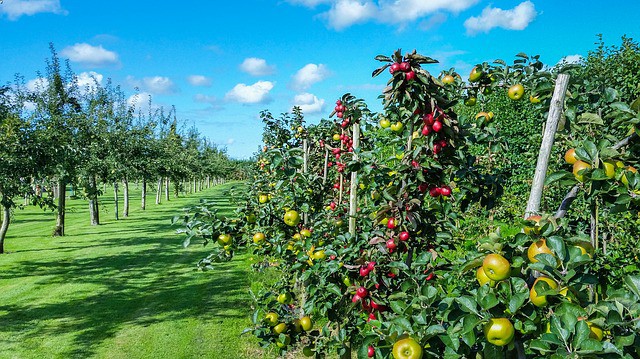
One of the most critical aspects of ensuring your apple trees grow strong and healthy is proper spacing. Adequate spacing allows for air circulation, sunlight penetration, and room for root expansion—these are crucial for reducing the risk of disease and ensuring good fruit production. While each variety of apple tree has its recommended spacing, the general rule of thumb is to provide enough room for them to mature without crowding.
When designing your orchard layout, consider the characteristics of each tree variety. If you plant them too closely together, it can lead to unhealthy trees with poor fruit quality. In addition, overcrowded trees may become stressed, making them more susceptible to pests and diseases. Proper spacing is essential for achieving the best yield and overall health of your apple orchard.
When planting apple trees, understanding the appropriate space between trees for specific varieties is essential for maximizing their growth potential and fruit output. Here is a breakdown for different types of apple trees:
Dwarf: 8 to 10 Feet
Dwarf apple trees are popular for home gardens due to their manageable size, making them ideal for limited spaces. They require approximately 8 to 10 feet between trees. This spacing allows them to spread their branches without interference while ensuring sufficient sunlight and air circulation. Despite their smaller stature, dwarf varieties can produce a surprising number of apples relative to their size, especially when well cared for.
Semi-Dwarf: 12 to 15 Feet
Semi-dwarf apple trees provide a balance between size and yield, needing about 12 to 15 feet of space between each tree. Their larger size offers apple growers the benefits of robust branching and ample fruit production while remaining manageable. This spacing is crucial for these trees to thrive without competing for resources with their neighbors.
Standard: 18 to 20 Feet
Standard apple trees are the largest variety and thus require the most space, necessitating an 18 to 20-foot distance between them. This significant spacing allows for maximum air circulation and sunlight exposure, which is vital for their health and productivity. Standard trees can grow quite tall, so providing enough space will help ensure that lower branches receive adequate sunlight and that you can harvest the apples easily.
Columnar: 2 to 3 Feet
For those with minimal space, columnar apple trees are a wonderful option. These trees only need 2 to 3 feet of space between them, making them perfect for patios and small gardens. Columnar varieties grow upwards instead of outwards, allowing for a compact orchard with a dense planting arrangement. However, even within limited spacing, it’s important to ensure that they receive enough light and air to maintain their health.
Frequently Asked Questions (FAQ) about Planting Apple Trees
What is the best time of year to plant apple trees?
The ideal time to plant apple trees is in early spring or late fall. In spring, it allows the tree to establish its roots before the heat of summer. Fall planting gives the tree a head start as it prepares for dormancy during the winter. Be sure to plant when the soil is workable and temperatures are moderate.
How many apple trees do I need to ensure good pollination?
To optimize pollination, it’s recommended to have at least two different apple tree varieties planted within 100 feet of each other. This encourages cross-pollination, which is essential for higher fruit yields and better quality apples.
How deep should I plant apple trees?
When planting apple trees, dig a hole that is wider than the root ball and deep enough so that the graft union (where the apple variety is grafted onto the rootstock) is level with or slightly above the soil line. This typically means planting the tree at a depth of about 1 to 2 inches above the old soil line from the nursery pot.
Can I plant apple trees in containers?
Yes, apple trees can be grown in containers, particularly dwarf and columnar varieties. Choose a container that is at least 18 to 24 inches wide and deep. Ensure proper drainage, and be mindful that container trees may need more frequent watering and fertilization compared to those planted in the ground.
What type of soil is best for apple trees?
Apple trees prefer well-drained, loamy soil that is rich in organic matter. The soil pH should ideally be between 6.0 and 7.0. If you have heavy clay or sandy soil, consider improving its texture with organic matter or compost for better drainage and nutrient retention.
How much sunlight do apple trees need?
Apple trees thrive on sunlight, requiring at least eight hours of direct sunlight each day. The more sun they receive, the better the fruit quality and quantity will be. Ensure they are planted in a location free from shadows cast by buildings or larger trees.
How far apart should I space apple trees?
The spacing between apple trees depends on the tree variety:
Dwarf trees: 8 to 10 feet apart
Semi-dwarf trees: 12 to 15 feet apart
Standard trees: 18 to 20 feet apart
Columnar trees: 2 to 3 feet apart
These distances allow for adequate air circulation and sunlight penetration, promoting healthy growth.
Do I need to prune apple trees?
Yes, regular pruning is crucial for apple trees. It helps to shape the tree, remove dead or diseased branches, and improve air circulation and light penetration. Pruning is best done in late winter or early spring before new growth begins.
How much water do apple trees need?
Apple trees generally require about an inch of water per week, either through rainfall or irrigation. During the first few years after planting, young trees may need more frequent watering—especially during dry spells—to establish strong roots.
What are common diseases or pests that affect apple trees?
Common pests include aphids, codling moths, and spider mites, while diseases such as apple scab, fire blight, and powdery mildew can also be problematic. Regularly inspect your trees for signs of damage and consider using organic pest control methods, like insecticidal soaps or neem oil, to combat these issues.





